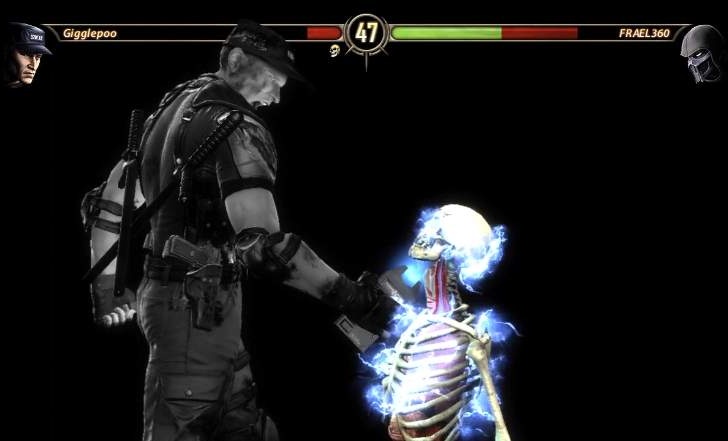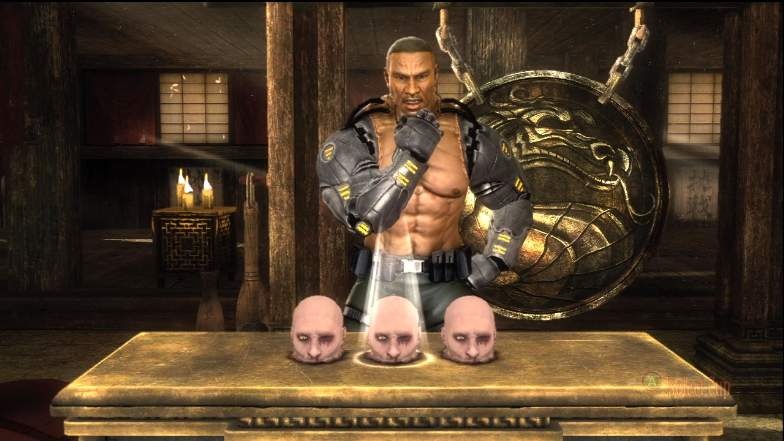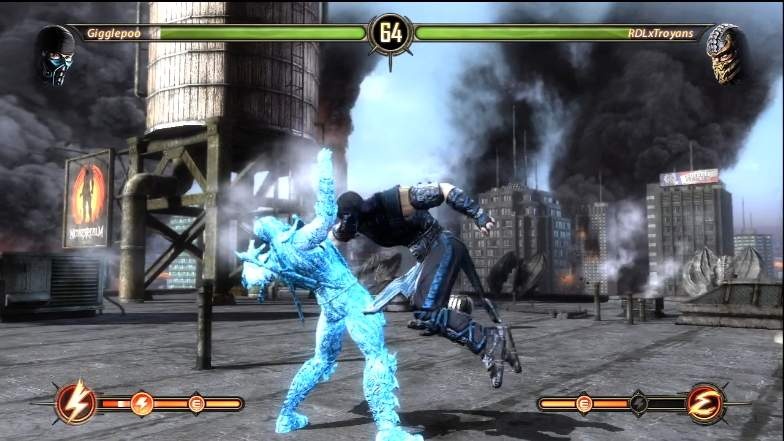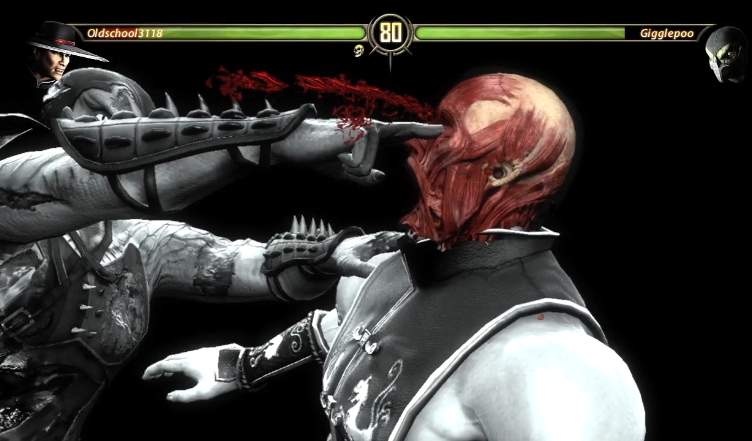As fighting games go, Mortal Kombat has always held a distinct place in the history of the genre, shunning the often cartoonlike style of its contemporaries in favor of gore and guts. Its latest incarnation is no different, pushing the boundaries of taste to the extreme with ludicrously over-the-top attacks that see you ripping your opponents in half, impaling them on spikes, and stamping on their chests while their internal organs bounce around like tetherballs. Subtlety and sophistication are not Mortal Kombat's strong points, but beneath its bloody exterior lies an engrossing 2D fighting game that manages to capture the feel of its forebears, while also offering new experiences for longtime fans.
Most fighting games have some kind of narrative backing up the action, but few do more with it than bookend their arcade modes with a few cutscenes. Not so in Mortal Kombat's Story mode. Each fight you have is punctuated by in-engine cinematics, taking you on a journey that reboots the narrative from the first three Mortal Kombat games. The story picks up where Mortal Kombat: Armageddon left off, with Thunder God Raiden under attack from Shao Kahn, an evil emperor hell-bent on merging Outworld with Earth Realm--a process that threatens to end all life on the planet. Raiden sends a message to his past self in order to prevent that outcome, which manifests itself as a series of visions. Though he's not entirely sure what the visions mean, Raiden proceeds to help the people of Earth Realm compete in the Mortal Kombat tournament, which decides the fate of the two worlds. By using the time travel mechanic, the story does a great job of introducing new players to the series, while also giving long time fans a new perspective on events. Be warned if you're not a fan of cut scenes, though. You can't skip them, even if you've already watched them when you resume a game. You also can't choose to replay specific sections of Story mode, even after you've conquered it; you either resume from your last save or start all the way from the beginning.
You initially take on the role of the actor Johnny Cage, whose arrogant personality and inordinate sexism make him something of a chore to listen to. Fortunately, you play as different fighters as you progress, most of which made an appearance in the first three games. They include classics such as Scorpion, Sub Zero, and Liu Kang, through to later additions such as Kabal, Smoke, and Sindel, who are unlocked from the start. You're also taken through a range of different environments, which look great. They're full of detail, re-creating some of the classic environments from previous games. One moment you're fighting beside a river of blood or in the fiery depths of the underworld, and the next you're being transported to an arena filled with giant monsters and chained-up slave girls. PlayStation 3 users have the option of playing in stereoscopic 3D, and also get a bonus character in the form of Kratos, complete with his Blades of Exile. Each time you switch characters in Story mode you learn about their origins and motivations for joining the tournament, whether that's revenge, bravery, or simply being in the wrong place at the wrong time. Though it would be inaccurate to say the story is particularly deep, it is entertaining, with tongue-in-cheek dialogue and a number of twists that keep you guessing--even if it gets a little absurd at times. Each character is well voiced, though, and because there's some motivation for the fighters' actions, there's more than just gameplay to keep you invested through until the end of the five-hour-plus narrative.
That's not to say the gameplay isn't enough to keep you entertained--far from it. Mortal Kombat makes a return to the single-plane 2D fighting that the series is known for, albeit with 3D models in place of digitised sprites. Your goal is to knock out your opponent using a range of kicks, punches, and special moves, such as knife throws, acid spit, and fireballs. You can chain moves together to perform combos, and also juggle your opponents by knocking them into the air and following up with additional attacks. Pulling off such moves is tricky, but things are made a little easier with a stripped back control scheme that harks back to the simple controls of the arcade originals, albeit with some tweaks. There are still four primary attack buttons, but rather than launching high and low attacks, each button now corresponds to a limb--similar to the control scheme from the Tekken series. Separate buttons perform blocks, while another performs throws. Though longtime fans may lament these changes, they actually make things a little easier, particularly if you're new to the series, as it's much more intuitive to perform low attacks by pushing down on the D pad or analogue stick.
The new controls are pleasingly responsive, with a feel that's very much reminiscent of Mortal Kombat II--that is, very fast. You need quick reflexes to dodge your opponent's attacks, as well as for finding those small openings in fights where you can squeeze in a punch and follow up with a devastating combo. Many of the button combinations for moves have been simplified. You still need speedy thumbs to enter in the button commands at the right time, but with less to remember it's easier than ever to pull off some impressive looking attacks. If you're used to playing the likes of Super Street Fighter IV, then the feel of Mortal Kombat will take some getting used to because the animation is less fluid. Moves don't string together as smoothly, so if you try to perform a combo that isn't in your character's repertoire, there's a delay between each attack, which feels jarring if you're not used to it. This doesn't make the game any less fun, though; it's just a different approach.

While the basic controls have been stripped back, a super meter has been introduced that gives you a few more options during a fight. As you receive and land hits, the meter builds up through three levels. The lowest level gives you access to enhanced moves. By holding down the block button while performing one of your character's special moves, that move becomes faster and more powerful, making it much trickier for your opponent to dodge. Fill the meter up to the second stage, and you can perform breakers--a type of counterattack. Tapping a directional button while holding down the block button breaks up an opponent's combo, letting you unleash a satisfying counterattack of your own, though getting the timing right does take some practice. Max out the meter, and you can perform devastating super combos called X-ray moves. These vary depending on your chosen character, but all are performed the same way, by holding down the block and stance buttons.
As each hit of the combo lands on your opponent, you're treated to a slow-motion X-ray view of your opponent's bones and organs being crushed in an excessive display of blood and guts that even the most hardcore of sadists will appreciate. Skulls are smashed, spines are broken, and knives are thrust into eyeball sockets, all accompanied by flying shards of bones and chilling sound effects that crunch and splat just right. Aside from the visual payoff, X-ray moves take off massive amounts of your opponent's health--so much so that it's often worth ignoring the first two stages of the super meter altogether, nullifying its strategic merits somewhat. Get the timing right and you can integrate X-Ray moves into your existing combos. They're especially useful if you're juggling--nothing screams pro more than launching your opponents into the air, landing a combo, and then, while they're completely helpless, smashing their skull with your boot in glorious X-Ray vision. While X-ray moves are powerful, they're not unstoppable; some can be blocked if they're not performed as part of a combo, and others can be dodged. They're also not the bloodiest of moves in the game--that accolade is reserved for fatalities.
Gruesome, a little disturbing, and so over-the-top they're downright hilarious at times, fatalities are performed at the end of fights. Depending on your chosen character, you can perform moves such as ripping the skin off opponents, slicing their bodies into quarters, or turning them into vapor with a barrage of explosive rockets. There are also stage fatalities that let you use the surrounding environment to kill opponents, such as by punching them into a pool of acid or dropping them onto a set of spikes and seeing their guts spill out. Traditionally, these moves have been difficult to perform, requiring complicated input commands and precise placement. Mortal Kombat makes things easier with simplified commands, some of which are the same for different characters. There's also a fatality training mode that shows you exactly where to stand and displays the button commands onscreen along with an input display, so you can see any mistakes you're making.
Strangely, that same input display doesn't appear in Tutorial mode, which teaches you the basics of fighting, such as how to punch, throw opponents, and dodge attacks. It's still useful, but if you're new to fighting games, an input display would make learning moves a little easier. The tutorial also gives you an introduction to another new addition to the series: tag team fighting. You can select up to two characters to fight on your team, switching between them using a single button. By holding down an action button while switching, you can unleash a range of tag team combos, which see your characters darting around the screen and taking down your opponent with a range of projectile attacks.
Ladder mode lets you try out your newfound tag team skills against a bunch of CPU opponents in a 10-fight tournament, though you can use just a single player if you prefer. Ladder is essentially an arcade mode where you must fight your way to the top and take on boss Shao Kahn in the last battle. Fighting Shao Kahn is difficult and extremely frustrating. He is one of the cheapest opponents you encounter, spamming you with a range of unblockable moves that seriously deplete your health bar. Worse still, you can't throw him, and if you don't manage to land a perfect combo when you attack, he absorbs the first hit and launches a counter of his own. If you do manage to defeat him, you're rewarded with an epilogue, which briefly tells you about what your character does after the tournament. It's little more than a simple voice-over set to 2D artwork, but it's a nice addition if you're craving a little more narrative after Story mode.
There's yet more content to play through in Challenge Tower, which acts as an extended tutorial, teaching you different strategies via a series of challenges and minigames that start off easy but become much harder as you progress. These range from standard fights where you can't block or use specials or have to perform eight-hit combos, through to minigames such as destroying a horde of zombies with Stryker's handgun or following a list of rapid-fire input commands to break a spell. The classic minigame Test Your Might also makes a return. You have to hammer a button to increase a power bar past a certain point, after which you unleash that power upon an object and hopefully break it. Test Your Strike is a variation on this, where you must fill the power bar to a certain point but not surpass it, which rewards precision rather than all-out button mashing. Another spin-off is Test Your Sight, which is a simple revolving-cup memory game. The Challenge Tower, Story, and Ladder modes are substantial and entertaining offerings, making Mortal Kombat one of the most content-rich fighting games out there.
That's before you even touch the multiplayer modes--the cornerstone of any good fighting game. As well as standard one-on-one versus modes, Mortal Kombat offers a tag team Ladder mode, where two players can join forces to take on the computer, or four people can do battle, with two players on each team. Online, there are even more options to choose from. Online players are divided up into lobbies of 10 players each. You can challenge any of the players in the lobby to a one-on-one or tag team match, or all 10 can compete in King of the Hill mode, which is essentially a mini-tournament. When you win a match you stay on until you either defeat all of your opponents or are defeated yourself, while the other members of the lobby watch. You can also jump into Ranked, Player, and Private matches without entering lobbies just by selecting the corresponding text, which throws you straight into a match. A leaderboard keeps track of your overall performance, based on the number of wins and losses you have. Matches are largely lag-free, though like in any online game, there are times when a bad connection causes the game to stutter significantly, making it tricky to compete.
Whether you fight online or offline, and in all but the offline versus mode, you're rewarded with coins for your victories. They are used to buy your way up the Challenge Tower if you're stuck on any particular challenge, or purchase new content in the Krypt, which is a virtual graveyard-cum-shopping-mall. There are hundreds of gravestones and corpses within the graveyard, each of which requires a certain number of coins to destroy and reveal the content underneath. Items such as concept art, character costumes, and music tracks can be unlocked, as well as more practical items such as new fatalities and Kombat Kodes, which unlock new game modes such as Headless Kombat and No Blood. If you complete Story mode, you can purchase most of the content in the Krypt, but doing so is a tedious process as you have to manually walk up to individual gravestones in first-person view and hit "purchase." Not all of Mortal Kombat's secrets are held within the Krypt, though, and there are hidden stage fatalities, Babalities, and fights to discover, as well as other Easter eggs that pay homage to the series' arcade roots.

With all that content, an in-depth Story mode, and a wide range of modes to play through, Mortal Kombat is one of the most complete fighting games around--not to mention one of the bloodiest. The return of fatalities and the addition of X-ray moves mean fans who have craved the return of gore after the toned-down Mortal Kombat vs DC Universe will have plenty to keep them amused. Likewise, the return to 2D fighting and a substantially tweaked control system have made the game more accessible for newcomers, seriously fast, and lots of fun. Plus, no other fighting game lets you knee your opponents in the groin and proceed to tear their bodies in half. And really, isn't that what Mortal Kombat is all about?

